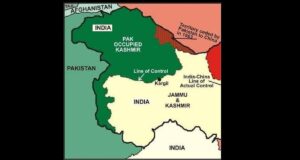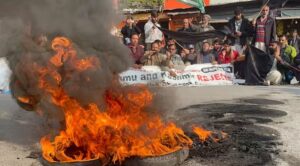5 Reasons Why Pakistan-administered Kashmir is Boiling Over Right Now
Protests erupt in Pakistan-administered Kashmir over rising taxes, power cuts and detentions. Residents allege discrimination by the Pakistani government. India asserts its claim on the region while tensions between India and Pakistan rise.
CONTENTS:

PoK Unrest Boils Over Taxes, Power Cuts
A new wave of unrest has emerged in Pakistan-administered Kashmir. The long-standing grievances of its residents over increasing taxes, inflation, and energy shortages have reached a boiling point. The recent detonation of stored sand has further fueled the turmoil in the region.
Before a scheduled meeting of the Jammu-Kashmir Joint Action Committee (JKJAC) on Saturday, the police arrested numerous leaders of the organization from Mujaffarabad and Mirpur on Thursday night. In response, a hartal was called in Uttar Pradesh on Friday. This strike has heightened tensions in Pakistan-administered Kashmir.

PoK Protest Turns Deadly: Tear Gas, Fire
Protesters engaged in clashes with both police and paramilitary forces in an attempt to prevent the march from proceeding. The situation escalated as tensions flared between the two groups in the area.
Amidst tear gas and gunfire, the momentum of the movement appears unstoppable. Allegations have surfaced not only of blank firing but also of shots targeting civilians. Reports indicate several protester fatalities during the clashes, although it remains unclear whether these deaths resulted from police gunfire.

Pok Simmers: Discontent Not New
This recent episode of turmoil in Pakistan-administered Kashmir is not an isolated event. Periodic instances of unrest have been commonplace in the region for various reasons. Pakistan grapples with issues such as food shortages and inflation, contributing to the ongoing challenges.
The repercussions of these issues extend to PoK as well. Some residents in the region express grievances, alleging discriminatory treatment by the Pakistani government.
The epicenter of unrest lies in Gilgit Baltistan within Pakistan-administered Kashmir. A faction of its residents has persistently advocated for joining India, primarily led by the youth. Following the revocation of Article 370 in India in 2019, the movement in Pakistan-administered Kashmir has gained momentum. Additionally, the Modi government has stepped up efforts to assert India’s claims over the region since then.

India Asserts Claim Over Pakistan-administered Kashmir
Prominent figures including Union Home Minister Amit Shah, Foreign Minister S Jaishankar, and Defense Minister Rajnath Singh have consistently asserted that Pakistan-administered Kashmir belongs to India. Prime Minister Narendra Modi has also referred to the concept of an “undivided India.”
Recently, the Indian Foreign Minister emphasized that PoK has never been a part of India and is an integral part of Pakistan. He highlighted a resolution passed by the Indian Parliament affirming Pakistan-administered Kashmir as part of India. Similarly, Defense Minister Rajnath Singh echoed this sentiment, suggesting that if India doesn’t take control of Pakistan-administered Kashmir, the deteriorating situation there could lead the region to willingly join India.

India’s Interest in Pakistan-administered Kashmir
The ongoing unrest in Pakistan-administered Kashmir raises the question of what India stands to gain from it. Many argue that the discriminatory treatment of Pakistan-administered Kashmir by the Pakistani government is fueling resentment among its residents, thereby increasing the desire for integration with India.
In the winter session of Parliament in 2023, the Indian government introduced the Jammu and Kashmir Reservation Bill, which reserved 24 seats in the Jammu and Kashmir Legislative Assembly for Pakistan-administered Kashmir. While presenting the bill, the Union Home Minister reiterated that Pakistan-administered Kashmir is an integral part of India.
History of India-Pakistan Conflict Over Kashmir
The historical conflict between India and Pakistan over Pakistan-administered Kashmir dates back several decades. Geographically, the region comprises two parts: one directly linked with Jammu and Kashmir, and the northern part known as Gilgit Baltistan, which shares borders with the western part of India.
During the partition of India and Pakistan in 1947, after much deliberation, King Hari Singh of the Jammu and Kashmir state opted to accede to India. On October 26, 1947, he signed the Instrument of Accession with India at the Amar Palace in Jammu, thereby associating Jammu and Kashmir with the Indian Union.
Protests and crackdown continues in Pakistan occupied Kashmir (PoK) pic.twitter.com/yzGoGPV5qo
— Sidhant Sibal (@sidhant) May 11, 2024
Escalating Tensions in Pakistan-administered Kashmir
Since 1947, tensions have persisted between India and Pakistan due to the dispute over Jammu and Kashmir. The conflict began in October 1947 and escalated in August 1965. It extends beyond Kashmir to include the Gujarat region. In 1971, India and Pakistan engaged in a war. In May 1999, the Pakistani army and militants attempted to infiltrate the Kargil border, resulting in India’s victory after a two-month-long operation named ‘Operation Vijay’. China has also been involved, notably expressing interest in the India-Pakistan conflict over Kashmir. Recently, the European Space Agency released a satellite image allegedly showing China constructing a road in a part of Pakistan-administered Kashmir, though the authenticity of this claim has not been verified by Anandabazar Online.
The Shahbaz Sharif administration is feeling the heat amidst the fresh tensions brewing over Pakistan-administered Kashmir. The Pakistani government is now contemplating strategies to suppress the protests.
Check out TimesWordle.com for all the latest news
Related Articles:
US State Dept. Report on Israel’s Gaza Actions & Palestine’s UN Membership: Key Updates
Math Genius Jim Simons Turned Billionaire Reveals His SHOCKINGLY SIMPLE Secrets to Success!
You must be logged in to post a comment.